Around the world, there is a lack of teaching innovation tools and methods in many subjects and we want to help bring innovation closer to anyone interested. In Helsinki capital region, the solution is 10 Days 100 Challenges. This isn’t just an ordinary innovation event where the outcome that you present only on the last day is important. The role of this event is to bring multi-faceted learning to each day. It’s a place where you get to learn, make mistakes, regroup and get guidance at any point – all while working with real companies trying to solve real problems.
The Innovation Process
The participants and the participating companies go through a design process. The company’s role is to provide the participants with one or more real business challenges that they currently have. Challenges that they have not been able to solve in a traditional way or that they are not equipped to solve either because of a lack of time or human resource. The role of the participants is to use the skills they have learned to tackle those real business problems through a defined, understood, and tested process.
For this event, we decided to follow a standard Stanford d.school design thinking process (Graphic 1).
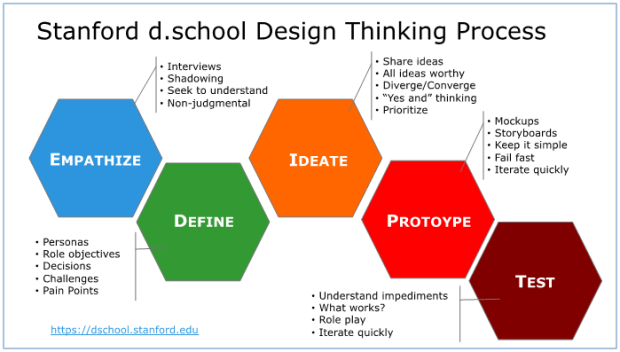
Graphic 1: The d.school Design Thinking Process (dschool.stanford.edu/resources)
The process in 5 steps:
- EMPATHISE = research the customer through various methods; learn who they are and what they do
- DEFINE = distill what you learned about your customer and define the challenges/pain points they are having
- IDEATE = co-create possibilities together and have as many ideas as you can, then sift through them and find the good ones
- PROTOTYPE = take 1, 2, or 3 of those good ideas and build simple prototypes of them and see how they work in reality – iterate what doesn’t work, fail fast, move forward
- TEST= test the iterated, simple prototypes with real people and in real situations; change what doesn’t work and create something useful
It was the job of the participants to follow these steps with the tools and methods they had been taught during the online course. The online course was also available as a resource for them to refer to during the process when/if needed.
The visual below was created so that everyone could understand what their role was and how they were expected to be engaging in the process; whether they were participants or company partners.
The central line describes the process to be undertaken while the top row explains the participant’s role:
- complete the online course
- interviews and review of company data
- explore real customer problems
- ideation and concepting
- building a testable prototype
- getting real feedback from users
- creating and delivering a solution pitch
The bottom part of the visual is all about what the company partners are expected to do:
- provide necessary company data
- be available for questions and coaching the teams when needed
- listen to the pitches and give feedback
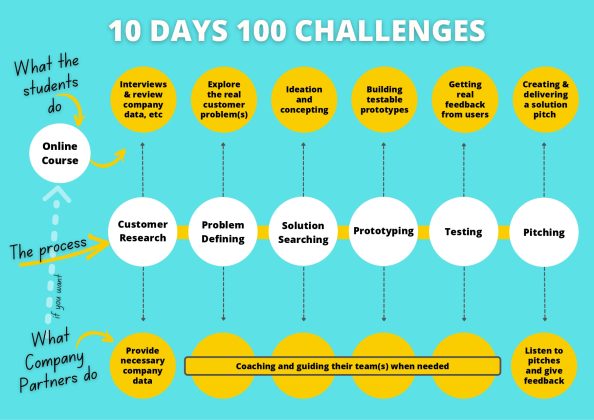
Graphic 2: The 10 Days 100 Challenges Overview.
Teams with mixed levels of knowledge and experience
The event starts by bringing diverse groups of students together to learn these tools and methods. This diversity provides some of the first challenge for the students, creating a common language so they can work effectively. Diversity is important because you never know who will be inspired to solve difficult problems in the future.
The participants are from Laurea, Haaga-Helia, and Metropolia Universities of Applied Sciences, and at different levels of knowledge and experience with this way of working and are purposefully mixed in their teams because of this. They are also mixed by their study level as some are Bachelor students and some are Master’s students.
It is a challenging seven days where students’ new knowledge is really put to the test. There are team dynamics to take into consideration, as we try to design the teams on 4 different points:
- field of study
- gender
- institution
- potential for already knowing the process.
Trying to keep all these in balance makes sure that most people are working with people they probably have not worked with (or even know) before.
Splitting the Event and the Learning
The online course format allowed the students to learn at their own pace and it also allowed students who normally would not have courses in innovation included in their courses to learn and experience a way of working that is considered a life-wide skill.
- The course was opened on May 2nd
- The course had to be completed by May 26th
- On May 27th we could see who had finished the course
- We let everyone know who should arrive on May 30th.
This worked really well and there were no participants that showed up without completing the course. We wanted to make sure that everyone had at least a basic idea of the process that they will be using for this event as there were students from many different faculties from three Universities of Applied Sciences (3UAS).
There were two immediate positive outcomes of splitting the event and the learning:
- The students were able to refer back to the course whenever they needed to refresh their memory about what expected or possible at that stage of the process.
- We can open up the learning to anyone who wishes to learn about this process. We can also make the learning available to companies and individuals outside of this specific 3UAS collaboration.
Developing the Event Concept
The 2022 10 Days 100 Challenges Event already had 4 years of history to build on.
- 2018 – First year, in-person
- 2019 – Second year, in-person
- 2020 – Cancelled due to Covid
- 2021 – Third year, digital event
- 2022 – Fourth year, in-person
Luckily 2022 allowed us to go back to the original concept and use the Helsinki XR Center as our venue. We made a conscious decision to not have a hybrid event as service design and design sprints are much harder to do when teams are split between online and in person.
Another difference in 2022, we wanted to reduce the number of in-person days the event ran as 10 full days, in person can be difficult to maintain enthusiasm and also to fit into schedules where the students are potentially starting summer jobs. Especially, as we still are just coming out of the restrictions we have lived through the past 2 years.
So, instead of learning and doing at the same time, we created an online course that gathered all the learnings together. This allowed us to reduce the event to seven days, Monday to Friday plus the following Monday and Tuesday.
What the Teams Accomplished
In the end, we had 13 teams giving final pitches for solutions to the companies that were all different and innovative in their own way. Some teams opted for simple ppt presentations, some used role play, and some incorporated their prototypes into their pitch. These different methods of presentation represented new skills the students had learned and also getting outside of their comfort zone. More challenges had been overcome.
The beauty in innovation events like this, is that people are open to trying so many new things. As they battle through the 100 Challenges of the event, they get outside of their comfort zone every day.
The event took place on May 30 – June 6 at Metropolia’s Helsinki XR Center – Arabia Campus. Read more on 10D100C website.

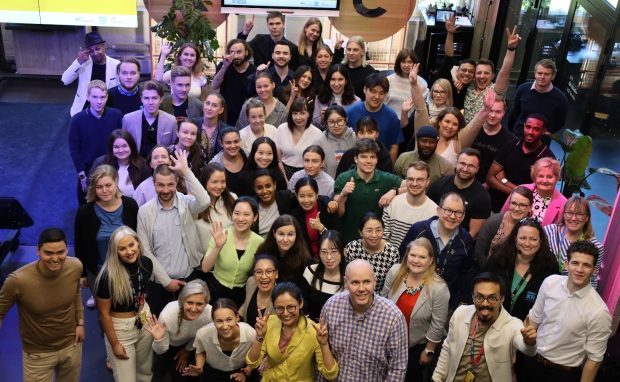

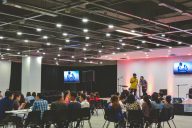
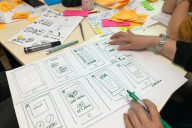




Ei kommentteja